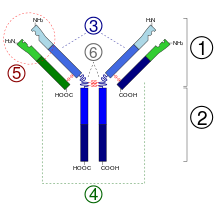Dysgammaglobulinemia is a type of immune disorder characterized by a reduction in some types of gamma globulins, resulting in heightened susceptibility to some infectious diseases where primary immunity is antibody based.[1]
| Dysgammaglobulinemia | |
|---|---|
 | |
| Schematic diagram of the basic unit of immunoglobulin (antibody) | |
| Pronunciation |
|
| Specialty | Hematology |
| Types | Selective immunoglobulin A deficiency, Selective IgE deficiency disease, IgG deficiency, and Isolated primary immunoglobulin M deficiency. |
It is distinguished from hypogammaglobulinemia, which is a reduction in all types of gamma globulins.[2]
There are four main types of dysgammaglobulinemia.[3]
Types
edit- Selective immunoglobulin A deficiency - Selective immunoglobulin A deficiency is classified as an IgA level below 7mg/dl (0.4375 μmol/L) with normal levels of other immunoglobulins. Some people with selective immunoglobulin A deficiency are prone to infections and develop other autoimmune disorders such as lupus, celiac disease and inflammatory bowel disease while others are completely asymptomatic.[4]
- Selective IgE deficiency disease - Selective IgE deficiency disease is characterized by IgE levels below <2 kIU/L with normal levels of other immunoglobulins. Selective IgE deficiency disease may be associated with an increased predisposition to certain sinopulmonary diseases, autoimmune disorders, infections, and malignancies.[5]
- IgG deficiency - IgG deficiency is a lack of IgG in the absence of other immunoglobulin deficiencies. IgG levels of 300–600 mg/dL show a mild to moderate reduction of IgG while levels below 200 mg/dl are classified as a severe deficiency.[6] Those with IgG deficiency often get chronic or reoccurring pyogenic respiratory tract infections.[7]
- Isolated primary immunoglobulin M deficiency - Isolated primary immunoglobulin M deficiency is classified as IgM levels under two SD of mean with normal levels of other immunoglobulins. Isolated primary immunoglobulin M deficiency often presents as recurring infections. Patients often improve with immunoglobulin therapy.[8]
See also
editReferences
edit- ^ a b "Dysgammaglobulinemia" at Dorland's Medical Dictionary
- ^ "hypogammaglobulinemia" at Dorland's Medical Dictionary
- ^ "Monarch Initiative". monarchinitiative.org. Retrieved 2023-11-27.
- ^ Yel, Leman (2010). "Selective IgA Deficiency". Journal of Clinical Immunology. 30 (1). Springer Science and Business Media LLC: 10–16. doi:10.1007/s10875-009-9357-x. ISSN 0271-9142. PMC 2821513. PMID 20101521.
- ^ Magen, Eli; Schlesinger, Menachem; David, Michael; Ben-Zion, Itzhak; Vardy, Daniel (March 1, 2014). "Selective IgE deficiency, immune dysregulation, and autoimmunity". Allergy and Asthma Proceedings. 35 (2). Oceanside Publications Inc.: 27–33. doi:10.2500/aap.2014.35.3734. ISSN 1088-5412. PMID 24717782. Retrieved 2023-11-27.
- ^ Agarwal, Shradha; Cunningham-Rundles, Charlotte (2007). "Assessment and clinical interpretation of reduced IgG values". Annals of Allergy, Asthma & Immunology. 99 (3). Elsevier BV: 281–283. doi:10.1016/s1081-1206(10)60665-5. ISSN 1081-1206. PMC 3099256. PMID 17910333.
- ^ Schwartz, Robert A (June 30, 2023). "Immunoglobulin G Deficiency Clinical Presentation: History, Physical, Causes". Medscape Reference. Retrieved November 27, 2023.
- ^ Gupta, Sudhir; Gupta, Ankmalika (September 5, 2017). "Selective IgM Deficiency—An Underestimated Primary Immunodeficiency". Frontiers in Immunology. 8. Frontiers Media SA: 1056. doi:10.3389/fimmu.2017.01056. ISSN 1664-3224. PMC 5591887. PMID 28928736.
Further reading
edit- Cheraghi, Taher; Kalantari, Arash; Shabestari, Mahnaz Sadeghi; Abolhassani, Hassan; Eibel, Hermann; Hammarström, Lennart; Kanegane, Hirokazu; Durandy, Anne; Plebani, Alessandro; Cunningham-Rundles, Charlotte; Aghamohammadi, Asghar (2021). "Predominantly antibody deficiencies". Inborn Errors of Immunity. Elsevier. doi:10.1016/b978-0-12-821028-4.00006-3. ISBN 978-0-12-821028-4. Retrieved 2023-11-27.
- van der Burg, Mirjam; Dalm, Virgil A.S.H.; Weemaes, Corry M.R. (2020). "Isotype defects". Stiehm's Immune Deficiencies. Elsevier. doi:10.1016/b978-0-12-816768-7.00020-x. ISBN 978-0-12-816768-7. S2CID 241231704. Retrieved 2023-11-27.
External links
edit- Dysgammaglobulinemia: Monarch Initiative Disease Ontology Dorland's Medical Dictionary
- Selective immunoglobulin A deficiency: Cleveland Clinic MerckManual EMedicine DermNet Mayo Clinic
- Selective IgE deficiency disease: Monarch Initiative Disease Ontology NCI Thesaurus
- IgG deficiency: Cedars Sinai Johns Hopkins EMedicine UpToDate
- Isolated primary immunoglobulin M deficiency: GARD Immune Deficiency Foundation UpToDate EMedicine